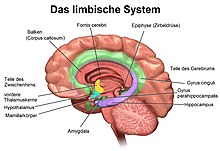Limbic system
The limbic system ( lat. Limbus “hem”) is a functional unit of the brain that is used to process emotions and the development of instinctual behavior . The limbic system is also credited with intellectual performance. The view of relating certain functions (such as the instincts) only to the limbic system and viewing them as functionally separated from the rest of the brain is now considered out of date. Other cortical and non-cortical structures of the brain exert an enormous influence on the limbic system. The emergence of emotion and instinctual behavior must therefore always be seen as an interplay of many parts of the brain and must not be attributed to the limbic system alone.
The limbic system is also responsible for the release of endorphins , i.e. the body's own opioids .
history
The term was introduced in 1878 by Paul Broca who defined a "limbic flap". The name “limbic” is derived from the Latin limbus (“hem”), as the associated structures form a double ring around the basal ganglia and the thalamus . Paul MacLean coined the term “limbic system” in 1952 and also assigned the amygdala to this functional structure.
The first functional theory was developed by James W. Papez in 1937 , the so-called Papez circle . However, since the 1990s, the concept of the limbic system has come under increasing criticism:
- Authors such as Rolf Kötter and Niels Meyer (1992) point out that there is no independent and generally recognized definition criterion - be it anatomical or functional - that could apply to all areas belonging to the limbic system. In response to this criticism, other authors have proposed the concept of an extended limbic system , which also includes parts of the cerebral cortex and the brain stem , or defended the term as a fuzzy limbic system (Isaacson).
- Other scientists who research the neural basis of emotions (e.g. Joseph LeDoux ) point out that emotions are not a monolithic phenomenon, but that very different neuronal substrates, e.g. B. fear or addiction.
anatomy
The structures of the limbic system form a double ring around the basal ganglia and the thalamus . It is formed from phylogenetically old parts of the cerebral cortex (paleopallium and archipallium, also allocortex ) and subcortical structures that lie medial to the hemispheres.
The limbic system is divided into the following anatomical structures (incomplete selection):
- Hippocampus
- Fornix
- Corpus mamillare
- Cingulate gyrus
- Corpus amygdaloideum ( amygdala , almond kernel)
- Nucleus anterior of the thalamus
- Habenulae (epithalamus)
- Parahippocampal gyrus
- Septum pellucidum
Each of these components has important functional connections to control centers in other brain regions. The connections with the midbrain are also known as the mesolimbic system .
Limbic system disorders
Changes in the limbic system or the amygdala can be observed in some diseases (e.g. memory disorders ; post-traumatic stress disorders ; narcolepsy ; autism ; depression ; phobias and Urbach-Wiethe syndrome ). A reduced ability to assess emotional situations is associated with it. Since many structures belong to the limbic system, it is difficult to assign individual diseases or disorders to this “functional unit”. Diseases can have many different causes, the origins of which may be assumed to be limited to specific parts of the limbic system.
Alzheimer's disease
The hippocampus - as part of the limbic system - is one of the first areas to be affected by Alzheimer's disease . Other brain changes associated with the disease are then largely concentrated on the neocortex and limbic cortex.
Bipolar disorder
A change in the function of the limbic system is also counted among the causes of bipolar disorder .
schizophrenia
On the biological level can be in schizophrenia using PET often a decreased activity of the frontal lobe , the watch . So-called hypofrontality - this is associated with limbic dysfunction and limited regulation of emotions and anxiety.
Web links
- limbic system , brain atlas
- Basics: Limbic system
Individual evidence
- ↑ Anatomy of the Brain ( Memento of the original from February 23, 2012 in the Internet Archive ) Info: The archive link was automatically inserted and not yet checked. Please check the original and archive link according to the instructions and then remove this notice. , Article at alzheimer-forschung.de
- ↑ Clemens Cherry: Biopsychologie from A to Z . Springer textbook, ISBN 3540396039 , p. 10 Lemma "Alzheimer's dementia".
- ↑ Causes of Bipolar Disease , article at medizinfo.de .
- ↑ Clemens Cherry: Biopsychologie from A to Z . Springer textbook, ISBN 3540396039 , p. 133 Lemma “Hypofrontality”.
